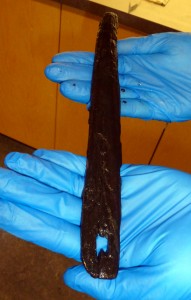Duncan McLaren, University of Victoria, B.C., Canada has submitted his preliminary report on wetland archaeological survey and coring work and wood and fiber artifact discoveries at an early Holocene site (over 7000 calendar years before present at base of shell midden). One piece is a large wooden needle possible used to weave eel or dune grass (see Figures 19-21). Any thoughts about the use of this kind of large wooden needle? Appears similar to what is called an eelgrass needle in some parts of the world.
The site is in traditional Bella Bella–Heiltsuk Kwakwakiwak native territory. We hope to report more on this site as the analysis proceeds: Hakai Ancient Landscape Archaeology Project Briefing Note July 2012
